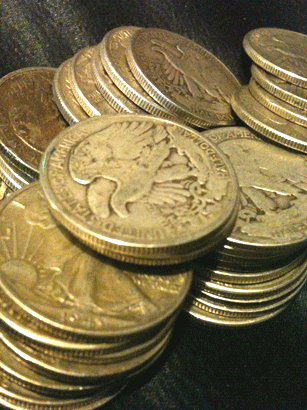What Is Junk Silver?
Plus a few words on culls, silver scrap and hacksilver...
Our Junk Silver Pages:
What Is Junk Silver? (this page) | Benefits Of Junk Silver | Buying Junk Silver Tips | Where To Buy Junk Silver | How To Sell Junk Silver | Junk Silver Bags
Share this page:

Above: Typical example of Junk Silver Coins:
USA 90% silver "Walking Liberty" Half Dollars.
Worth around $13 each in Feb. 2012
Junk silver is a common-parlance nickname used in the USA, United Kingdom, Canada and Australia for circulated old silver coins which don't have any collectible or trade value greater than the bullion value of the silver they contain. The term "circulated" means that they were once in ordinary circulation. The term "junk silver" refers to coins, not necessarily to scrap silver in other forms - which simply goes by the name "silver scrap".
Although they are called junk silver coins, the coins are typically not damaged, bent or excessively worn. They are simply regular used coins, with actual silver content, that don't have numismatic or special rarity value to collectors.
Junk silver coins generally date from the latter part of the 19th century to the first half of the 20th century. Unless they are very worn, coins that are older than mid to late 19th century start to become more valuable to collectors than for their silver content alone. Coins that are more recent than the mid 20th century are no longer made with actual silver, apart from special collectors coins and bullion coins that are worth more to collectors and are "not junk".
The date that real silver was "phased out" of coin usage varies depending on the country and denomination of coin - and it is important to have the right information so that you can calculate the actual silver content of coins. For example, the last year silver was included in general circulation coins minted in the UK was 1946 - although the coins continued to be legal tender for many years and some of these coins were still still in general circulation - in gradually declining numbers - until the 1970's.
Culls
Coins that are bent, drilled corroded, damaged or have any other "major issues" are known as culls or cull coins and these "actual junk" coins are sometimes seen for sale at discounted prices. Culls are sometimes also known as basal state coins, filler coins or poor (grade) coins. However, so long as the coin is ascertainable as being of the correct silver content, the bullion trader doesn't care if it looks bad - it's all about the silver weight. So if cull coins can be obtained under spot and their silver content is verifiable... remember that the silver is still silver!
Hacksilver
One last piece of nomenclature for you - hacksilver. Hacksilver is pieces or fragments of silver that was used as bullion / currency in ancient times. It was the medieval equivalent of silver scrap - only it was sometimes kept and traded instead of being melted down and appears to have been deliberately cut into pieces so as to be more easily tradeable.
Hacksilver was common among the Norsemen and Vikings, and is sometimes found as part of ancient silver hoards dating from the medieval era or dark ages. Curiously, hacksilver hoards often contain cut-up pieces of what was once high quality silverware - leading to speculation as to why the items were destroyed. It appears that, lacking enough coins, silver items were cut into pieces out of necessity, so as to be tradeable for other commodities of lesser value.
A further demonstration of this phenomenon was sen during the "siege period" of the reign of the English king Charles I. In the 1640's, Charles was "on the run" and made makeshift coins to pay his soldiers from cut-up pieces of silver plate. Another example - the Russian coin, the "Ruble", derives from a word meaning "to chop".
So it appears likely that hacksilver was a type of home-made currency. Yet more evidence that in unstable times, old silver items have a tendency to return to use as currency. Perhaps it's all just the same as it ever was...
Please note - please be aware that buying and selling bullion items is highly speculative and there are of course substantial financial risks. This web site is not investment advice and we do not make any actual recommendations.




